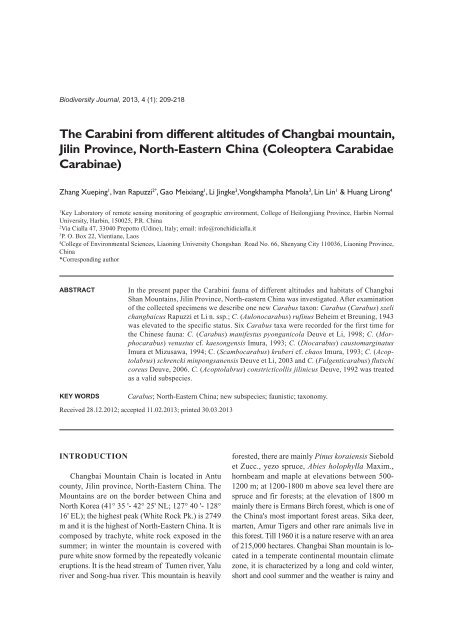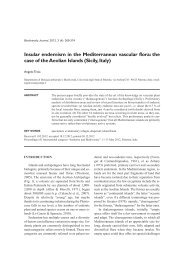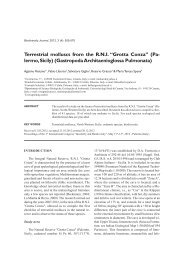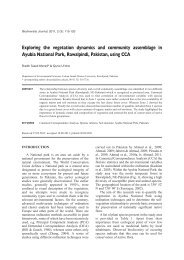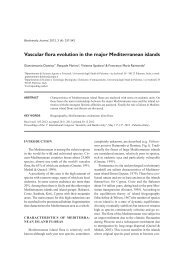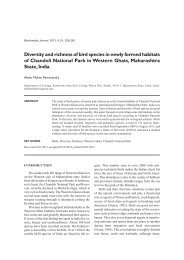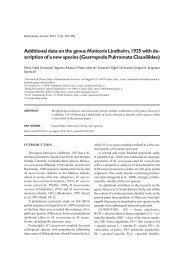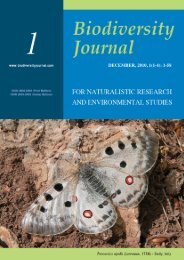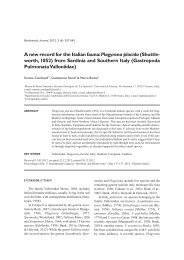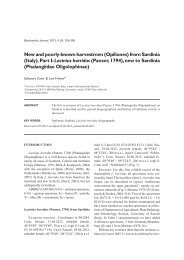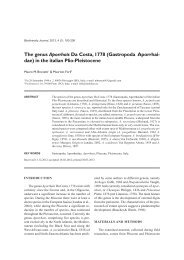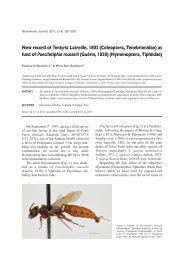Zhang Xueping, Ivan Rapuzzi, Gao Meixiang, Li Jingke ...
Zhang Xueping, Ivan Rapuzzi, Gao Meixiang, Li Jingke ...
Zhang Xueping, Ivan Rapuzzi, Gao Meixiang, Li Jingke ...
Create successful ePaper yourself
Turn your PDF publications into a flip-book with our unique Google optimized e-Paper software.
Biodiversity Journal, 2013, 4 (1): 209-218The Carabini from different altitudes of Changbai mountain,Jilin Province, North-Eastern China (Coleoptera CarabidaeCarabinae)<strong>Zhang</strong> <strong>Xueping</strong> 1 , <strong>Ivan</strong> <strong>Rapuzzi</strong> 2* , <strong>Gao</strong> <strong>Meixiang</strong> 1 , <strong>Li</strong> <strong>Jingke</strong> 3 , Vongkhampha Manola 3 , <strong>Li</strong>n <strong>Li</strong>n 1 & Huang <strong>Li</strong>rong 41Key Laboratory of remote sensing monitoring of geographic environment, College of Heilongjiang Province, Harbin NormalUniversity, Harbin, 150025, P.R. China2Via Cialla 47, 33040 Prepotto (Udine), Italy; email: info@ronchidicialla.it3P. O. Box 22, Vientiane, Laos4College of Environmental Sciences, <strong>Li</strong>aoning University Chongshan Road No. 66, Shenyang City 110036, <strong>Li</strong>aoning Province,China*Corresponding authorABSTRACTIn the present paper the Carabini fauna of different altitudes and habitats of ChangbaiShan Mountains, Jilin Province, North-eastern China was investigated. After examinationof the collected specimens we describe one new Carabus taxon: Carabus (Carabus) szelichangbaicus <strong>Rapuzzi</strong> et <strong>Li</strong> n. ssp.; C. (Aulonocarabus) rufinus Beheim et Breuning, 1943was elevated to the specific status. Six Carabus taxa were recorded for the first time forthe Chinese fauna: C. (Carabus) manifestus pyonganicola Deuve et <strong>Li</strong>, 1998; C. (Morphocarabus)venustus cf. kaesongensis Imura, 1993; C. (Diocarabus) caustomarginatusImura et Mizusawa, 1994; C. (Scambocarabus) kruberi cf. chaos Imura, 1993; C. (Acoptolabrus)schrencki minpongsanensis Deuve et <strong>Li</strong>, 2003 and C. (Fulgenticarabus) flutschicoreus Deuve, 2006. C. (Acoptolabrus) constricticollis jilinicus Deuve, 1992 was treatedas a valid subspecies.KEY WORDSCarabus; North-Eastern China; new subspecies; faunistic; taxonomy.Received 28.12.2012; accepted 11.02.2013; printed 30.03.2013INTRODUCTIONChangbai Mountain Chain is located in Antucounty, Jilin province, North-Eastern China. TheMountains are on the border between China andNorth Korea (41° 35 '- 42° 25' NL; 127° 40 '- 128°16' EL); the highest peak (White Rock Pk.) is 2749m and it is the highest of North-Eastern China. It iscomposed by trachyte, white rock exposed in thesummer; in winter the mountain is covered withpure white snow formed by the repeatedly volcaniceruptions. It is the head stream of Tumen river, Yaluriver and Song-hua river. This mountain is heavilyforested, there are mainly Pinus koraiensis Sieboldet Zucc., yezo spruce, Abies holophylla Maxim.,hornbeam and maple at elevations between 500-1200 m; at 1200-1800 m above sea level there arespruce and fir forests; at the elevation of 1800 mmainly there is Ermans Birch forest, which is one ofthe China's most important forest areas. Sika deer,marten, Amur Tigers and other rare animals live inthis forest. Till 1960 it is a nature reserve with an areaof 215,000 hectares. Changbai Shan mountain is locatedin a temperate continental mountain climatezone, it is characterized by a long and cold winter,short and cool summer and the weather is rainy and
The Carabini from different altitudes of Changbai mountain, Jilin Province, North-Eastern China 211Fig. 1. C. (A.) rufinus, locality Q1, 28.5 mm. Fig. 2. Idem, aedeagus frontal view. Fig. 3. Idem, aedeagus lateral view. Fig. 4. C.(A.) canaliculatus vojnitsi, locality Q3, 29 mm. Fig. 5. Idem, aedeagus frontal view. Fig. 6. Idem, aedeagus lateral view. Fig. 7.Idem, holotype, 25 mm, with label. Fig. 8. Idem, holotype, details of head and pronotum. Fig. 9. Idem, holotype, aedeagus frontalview. Fig. 10. Idem, holotype, male aedeagus lateral view. Fig. 11. C. (L.) seishinensis elongatipennis, locality Q1, 25.2 mm.
212Z. XUEPING ET ALIIFig. 12. C. (S.) kruberi cf. chaos, locality Q1, 23.3 mm. Fig. 13. C. (T.) fraterculus gaixianensis, locality Q1, 21mm. Fig.14. C. (T.) fraterculus neochinensis, locality Q3, 16.8 mm. Fig. 15. C. (D.) caustomarginatus, locality Q2, 20 mm. Fig. 16.C. (C.) granulatus telluris, locality Q1, 22.9 mm. Fig. 17. C. (C.) arvensis faldermanni, locality Q3, 19.1 mm.
214Z. XUEPING ET ALIIalso the aedeagus is different: larger and more regularlycurved. Further investigations will be necessaryto better understand the systematic position ofC. smaragdinus on Changbai Shan Mountains. Ifnot any transition forms between liaodongensis andcoreicus will found at intermediate altitude, the twoforms must be treated as valid species. Under thatconsideration it will be possible that C. (Damaster)smaragdinus and C. (Damaster) branickii representtwo different species.- C. (Fulgenticarabus) flutschi coreus Deuve,2006 (Fig. 33) The collected specimens belong tothe subspecies coreus Deuve, 2006 described andknown from a single locality in North Korea (Yanggang,Mt. Samjiyon San) not far from ChangbaiShan. New subspecies for the Chinese fauna.Q3. Bai-shan-shang-fang, elevation 1850m. Ermans Birch forest- Calosoma (Calosoma) inquisitor cyanescensMotschulsky, 1859.- C. (Aulonocarabus) canaliculatus vojnitsiMandl, 1979 (Fig. 4). As written above, in this localitywe observed the cohabitation of two Carabus(Aulonocarabus) taxa: C. (Aulonocarabus) rufinusBeheim et Breuning, 1943 and C. (A.) canaliculatusvojnitsi Mandl, 1979: the specimens with elongatebody, brown elytra and very dilated apex of aedeagusare C. (A.) rufinus; the specimens with blackelytra, shorter body, larger pronotum and tiny apexof aedeagus are C. (A.) canaliculatus vojnitsi.- C. (Aulonocarabus) rufinus Beheim et Breuning,1943- C. (Tomocarabus) fraterculus neochinensisDeuve et <strong>Li</strong>, 1998 (Fig. 14). By the smaller bodysize, the more regular elytral sculpture and the blackcolor, the specimens correspond exactly with thesubspecies neochinensis Deuve et <strong>Li</strong>, 1998.- C. (Carabus) arvensis faldermanni Dejean,1829 (Fig. 17). The taxon is known from differentlocalities of North-Eastern China, Far East RussiaNorth Korea; few localities are reported from SouthKorea (Kwon & <strong>Li</strong>, 1984).- C. (Carabus) szeli changbaicus n. ssp. See descriptionbelow.Fig. 18. C. (C.) manifestus pyonganicola, locality Q1, 22.4 mm. Fig. 19. C. (C.) szeli changbaicus n. ssp., holotype male,21 mm. Fig. 20. Idem, aedeagus frontal view. Fig. 21. Idem, aedeagus lateral view.
The Carabini from different altitudes of Changbai mountain, Jilin Province, North-Eastern China215Fig. 22. C. (M.) hummeli pusongensis, locality Q1, 25.2 mm. Fig. 23. C. (M.) wulffiusi dekraatzi, locality Q1, 22 mm. Fig.24. C. (M.) venustus cf. kaesongensis, locality Q4, 16.8 mm. Fig. 25. C. (M.) vietinghoffi caesareus, locality Q1, 28.9 mm.Fig. 26. C. (A.) schrencki schrencki, locality Q1, 24,5 mm. Fig. 27. C. (A.) schrencki minpongsanensis, locality Q2, 24 mm.
216Z. XUEPING ET ALIIFig. 28. C. (A.) constricticollis jilinicus, locality Q1, 28.8 mm. Fig. 29. C. (D.) jankowskii jankowskii, locality Q2, 32.7mm. Fig. 30. C. (D.) jankowskii lii, locality Q1, 36.5 mm. Fig. 31. C. (D.) smaragdinus liaodongensis, locality Q1, 33 mm.Fig. 32. C. (D.) smaragdinus coreicus, locality Q3, 37.7 mm. Fig. 33. C. (F.) flutschi coreus, locality Q2, 20.6 mm.
The Carabini from different altitudes of Changbai mountain, Jilin Province, North-Eastern China217- C. (Morphocarabus) venustus cf. kaesongensisImura, 1993. The specimens collected on the highaltitude of the Changbai Shan are very similar to thespecimens from the adjacent areas of North Korea.By the morphological characters they belong to C.(M.) venustus kaesongensis Imura, 1993. New subspeciesfor the Chinese fauna.- C. (Damaster) smaragdinus coreicus Hauser,1921 (Fig. 32).Q4. Nearby Tianchi weather station, elevation2100 m. Tundra belt- C. (Aulonocarabus) rufinus Beheim et Breuning,1943.- C. (Tomocarabus) fraterculus neochinensisDeuve et <strong>Li</strong>, 1998 New subspecies for the Chinesefauna.- C. (Morphocarabus) venustus cf. kaesongensisImura, 1993 (Fig. 24).New taxonCarabus (Carabus) szeli changbaicus<strong>Rapuzzi</strong> et <strong>Li</strong> n. ssp.Holotype: 1 male, Huang-song-pu-lin-chang,1300 m., Mt. Changbai Shan, Antu county, Jilinprovince, China. 13/15.VI.2012 (Coniferous forest);preserved in <strong>Ivan</strong> <strong>Rapuzzi</strong> collection, Prepotto(UD), Italy. Paratype: 1 male, Baishan-shang-fang,1850 m., Mt. Changbai Shan,Antu county, Jilin province, China. 13/15.VI.2012(Ermans Birch forest); preserved in Key Laboratoryof remote sensing monitoring of geographicenvironment, Harbin, China.DESCRIPTION OF HOLOTYPE MALE. Length includingmandibles: 21 mm (Fig. 19), maximumwidth of elytra: 7.1 mm. Color black with metallicluster on head, dorsum and pronotum cupped withmargin of elytra green. Very close to C. (Carabus)szeli Deuve, 1994 but separate by ticked head,more parallel elytra with stronger elevated intervals.Aedeagus (Figs. 20, 21) longer and thin; apexmore regular curved in frontal view. In lateral viewthe apex is a little larger and more curved on the left.VARIABILITY. In general very little variability: thelength of the body is 20.3 mm. The color is moregreen and shiny.Q1 locality N-E China KoreaPeninsula1) C. rufinus X2) C. seishinensis elongatipennis X3) C. kruberi cf. chaos X4) C. fraterculus gaixianensis X5) C. hummeli pusongensis X X6) C. wulffiusi dekraatzi X7) C. granulatus telluris X X8) C. manifestus pyonganicola X9) C. vietinghoffi caesareus X10) C. schrencki X11) C. constricticollis jilinicus X12) C. jankowskii lii X13) C. smaragdinus liaodongensis X10 taxa 5 taxaQ2 locality1) C. rufinus X2) C. caustomarginatus X3) C. manifestus pyonganicola X4) C. szeli changbaicus n. ssp. X5) C. schrencki minpongsanensis X6) C. constricticollis jilinicus X7) C. jankowskii X8) C. smaragdinus coreicus X9) C. flutschi coreus X3 taxa 6 taxaQ3 locality1) C. canaliculatus vojnitsi X2) C. rufinus X3) C. fraterculus neochinensis X X4) C. arvensis faldermanni X X5) C. szeli changbaicus n. ssp. X6) C. venustus cf. kaesongensis X7) C. smaragdinus coreicus X5 taxa 5 taxaQ4 locality1) C. rufinus X2) C. fraterculus neochinensis X X3) C. venustus cf. kaesongensis X2 taxa 2 taxaTable 1. The Carabus fauna of Changbai Shan.
218Z. XUEPING ET ALIICONCLUSIONSThe Carabini fauna of Changbai Shan Mountainis of a great interest. The study of the collected specimensfrom different altitudes and habitats permittedus to (i) describe one new Carabus taxon: C. szelichangbaicus n. ssp., (ii) record for the first time sixnew Carabus taxa for the Chinese fauna; and (iii)better understand the systematic position of Carabus(Aulonocarabus) canaliculatus Adams, 1812 speciesgroup and the status of C. (Acoptolabrus) constricticollisjilinicus Deuve, 1992. Further investigationswill be necessary to clarify the status of C. (Coptolabrus)smaragdinus/branickii group that will bepossibly to be treated as separate species.The Carabini fauna of Changbai Shan is veryrich: 23 Carabus taxa and 1 Calosoma species wererecorded. In general the Carabus fauna is somethingintermediate between the "classic" fauna ofNorth-Eastern China (9 taxa) and Korean Peninsulafauna (11 taxa); one taxon seems to be endemic (C.szeli changbaicus n. ssp.) but it belongs to a typicalspecies group from Korean Peninsula (C. angustusspecies group) and 3 species are widespread inNorth-Eastern China and Korean Peninsula. Wealso found some differences in the Carabus faunafrom the four investigated areas of the ChangbaiShan Mountains. In fact many of the Carabus speciescollected at the lower altitude on the Westernslope of the mountain (locality Q1, 800 m) belongto the classic species known from North-EasternChina. Instead the Carabus from medium-high altitudeson Changbai Shan Mountain (localitiesfrom Q2 to Q4, 1300/2100 m) are mainly the typicalspecies from the North Korea fauna.The table 1 report the collected Carabus taxafrom every investigated localities and their main distribution.ACKNOWLEDGEMENTSWe wish to thank Dr. Thierry Deuve (Paris,France) and Dr. Otto Merkl (Budapest, Hungary)for loaning to one of us (I.R.) the holotypes of differentCarabus (Aulonocarabus) taxa necessary todeterminate the collected specimens. This work wassupported by a grant from the National ScienceFoundation of China (No. 41071033; No.41101049), Innovation Talents Fund for Scienceand Technology of Harbin: 2011RFXXN039. Supportedby China Postdoctoral Science Foundation(2012M511361).REFERENCESDeuve Th., 2012. Une nouvelle classification du genreCarabus L., 1758. Association Magellanes: 1-56.Deuve Th. & <strong>Li</strong> J. K., 2000a. Diagnoses des trois nouveauxCarabus L. de la Chine, de la Corée et du Pakistan(Coleoptera, Carabidae). Coléoptères, 6: 55-76.Deuve Th. & <strong>Li</strong> J. K., 2000b. Esquisse pour la connaissancedu genre Carabus L. en Chine du Nord-Est(Carabidae). Lambillionea, 100: 502-530.Deuve Th., <strong>Li</strong> J.K. & <strong>Zhang</strong> X.P., 2011. Sur quelques Carabinaedu Nord-East de la Chine (Coleoptera, Carabidae).Les Coléoptériste, 14: 55-61.Kwon Y.J. & Lee S.-M., 1984. Classification of the subfamilyCarabinae from Korea (Coleoptera: Carabidae).Insecta koreana, 4: 1-148, 107 pl.


